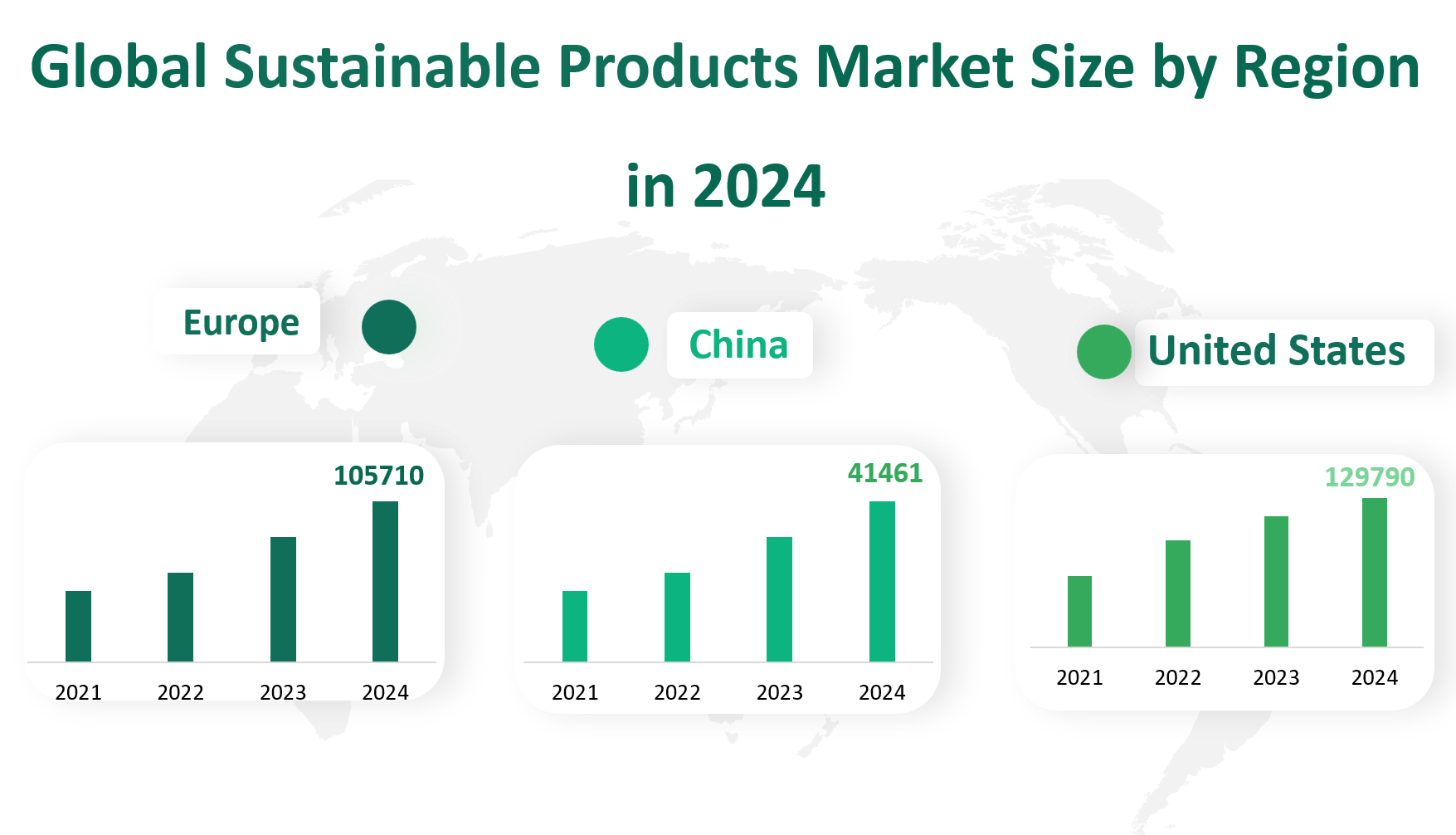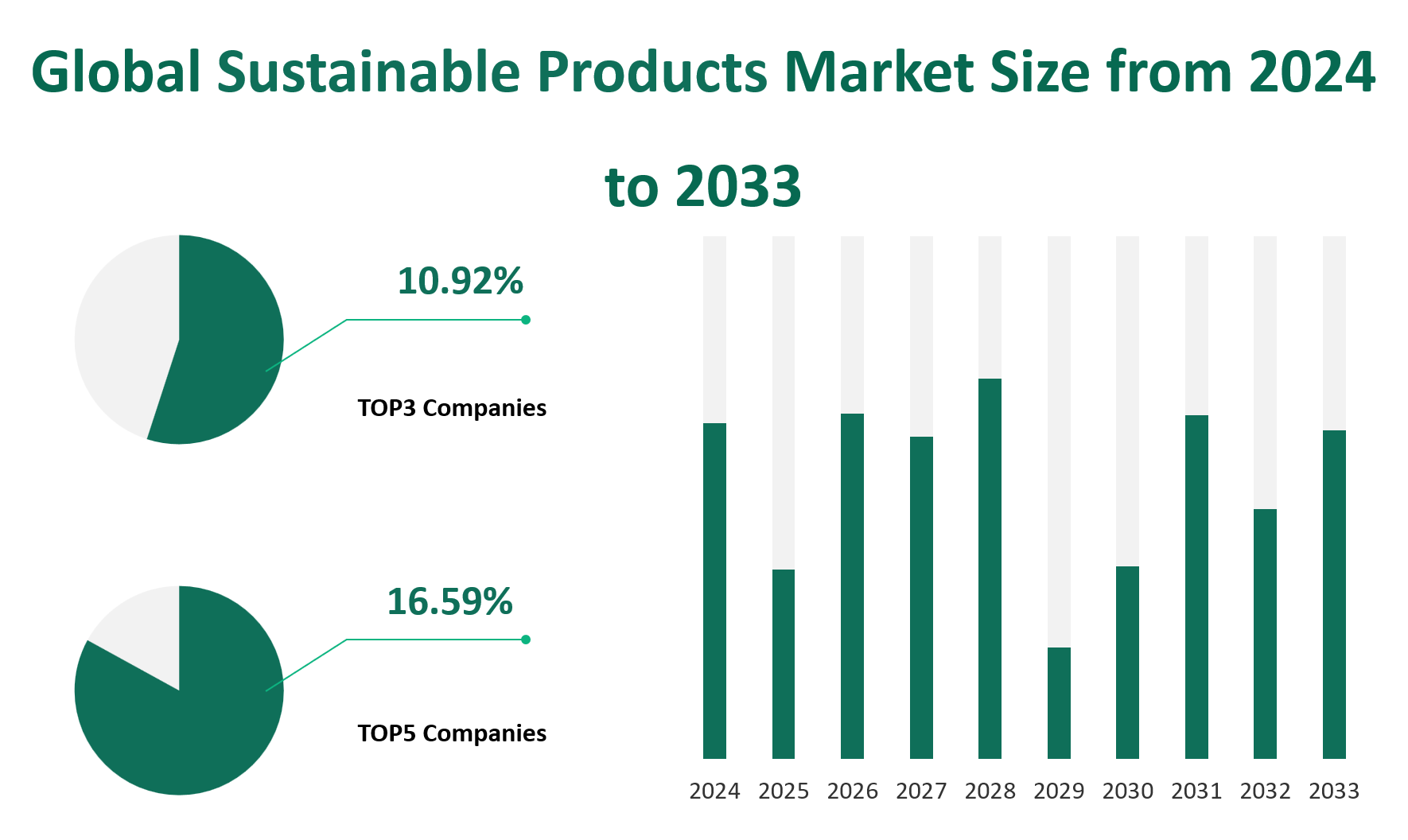1. Global Sustainable Products Market Size and CAGR (2024-2033)
The global Sustainable Products Market, valued at 355.06 billion USD in 2024, is anticipated to witness significant growth in the coming years, with a Compound Annual Growth Rate (CAGR) of 7.63% predicted for the period 2024-2033.
Sustainable products are defined as those that offer benefits to society, the environment, and the economy throughout their lifecycle, from raw material extraction to final disposal, while also safeguarding human health and the environment. These products are increasingly recognized by consumers for their role in promoting sustainable development concepts, particularly in packaging materials for downstream sectors such as food and beverage, personal care, and healthcare.
Figure Global Sustainable Products Market Size (M USD) and CAGR 2024-2033

2. Driving and Limiting Factors of Sustainable Products Market Growth
The growth of the sustainable products market is propelled by several driving factors. Firstly, there is a rising consumer consciousness regarding environmental protection and sustainability, leading to an increased demand for eco-friendly products. This is further supported by national policies that encourage sustainable production and consumption, aiming to reduce environmental impact and ensure resource preservation for future generations.
However, the market faces certain challenges and limitations. One of the primary constraints is the high cost associated with sustainable products, which often price them higher than traditional alternatives. This cost barrier can limit consumer choice and hinder market expansion. Additionally, supply chain challenges, such as reliance on a limited network of suppliers and the vulnerability to global trade tensions and tariffs, add complexity to the market’s growth. The lack of transparency and robust certification and labeling systems also deter consumers from choosing sustainable products, creating a barrier to market growth.
3. Technology Innovation, Mergers, and Acquisitions in the Sustainable Products Market
Technology innovation plays a pivotal role in the sustainable products market. Advancements in material science, design, and production processes are driving the market forward. For instance, the shift towards biodegradable materials, such as those derived from natural resources like algae, corn starch, or sugar cane, is a significant trend. Additionally, the development of detachable, modular, and recyclable packaging designs is gaining importance, reducing waste and promoting sustainable consumption.
Corporate mergers and acquisitions have also been a key aspect of market growth, with major players expanding their reach and capacity. For example, Amcor’s acquisition of Phoenix Flexibles and Sealed Air’s acquisition of Liquibox demonstrate the industry’s consolidation and focus on expanding into high-growth markets. These strategic moves not only strengthen the companies’ positions but also contribute to the overall growth and innovation within the sustainable products market.
4. Global Sustainable Products Market Size and Share by Type
The sustainable products market is segmented by type into Recycled Content, Recyclable & Reusable, and Degradable products.
Recycled Content products refer to items that contain a significant percentage of recycled materials, including both pre- and post-consumer waste. These products are pivotal in reducing the demand for virgin materials and promoting a circular economy. In 2024, the Recycled Content segment is estimated to have a market size of 45567 K Tons, with a CAGR of 8.15% from 2019 to 2033, indicating a robust growth trajectory.
Recyclable & Reusable products are those designed to be used multiple times, either for the same purpose or repurposed for new functions. This category encourages reduced waste and extended product lifecycles. With a market size of 99502 K Tons in 2024, this segment holds the largest market share and is expected to maintain its dominance with a CAGR of 6.20% from 2019 to 2033.
Degradable products are those that can break down through chemical or biological means, offering an alternative to traditional plastics and reducing long-term environmental impact. Although the smallest in terms of market size with 18567 K Tons in 2024, this segment exhibits the fastest growth rate at 9.03% CAGR from 2019 to 2033, reflecting a rapidly emerging market due to increasing environmental concerns.
Among these, the Recyclable & Reusable products hold the largest market share in 2024, while the Degradable products show the fastest growth rate, indicating a significant market potential for environmentally friendly alternatives.
Table Global Sustainable Products Market Size and Share by Type in 2024
|
Type |
Market Size (K Tons) 2024 |
Market Share 2024 |
|
Recycled Content |
45567 |
27.85% |
|
Recyclable & Reusable |
99502 |
60.81% |
|
Degradable |
18567 |
11.35% |
5. Global Sustainable Products Market by Application
The applications of sustainable products are diverse, spanning across Food & Beverages, Personal Care, Healthcare, and Others.
Food & Beverages is the largest application segment, accounting for a significant portion of the sustainable products market. This is due to the high demand for eco-friendly packaging in the food and beverage industry. In 2024, this segment is projected to have a market size of 78184 K Tons, with a CAGR of 7.02% from 2019 to 2033.
Personal Care products, which include sustainable packaging for cosmetics and personal hygiene products, are also gaining traction. With a market size of 22394 K Tons in 2024, this segment is expected to grow at a CAGR of 7.41% from 2019 to 2033.
Healthcare applications of sustainable products, such as packaging for medical devices and pharmaceuticals, are critical for maintaining the integrity and safety of healthcare products. This segment has a market size of 15381 K Tons in 2024 and is anticipated to grow at a CAGR of 8.01% from 2019 to 2033, making it the fastest-growing application segment.
In conclusion, the Food & Beverages application holds the largest market share in 2024.
Table Global Sustainable Products Market Size and Share by Application in 2024
|
Application |
Market Size (K Tons) 2024 |
Market Share 2024 |
|
Food & Beverages |
78184 |
47.78% |
|
Personal Care |
22394 |
13.69% |
|
Healthcare |
15381 |
9.40% |
|
Others |
47677 |
29.14% |
6. Global Sustainable Products Market by Region
The market is segmented by region into the United States, Europe, China, Japan, Australia, Southeast Asia, Latin America, the Middle East and Africa, and others.
United States continues to be a dominant player in the global sustainable products market, with a revenue of approximately 129,790 million USD in 2024. The United States has been at the forefront of adopting sustainable practices and has a well-established market for sustainable products. The region’s growth rate is projected to be around 7.54%, highlighting its steady and consistent market expansion.
Europe is another significant regional market, with a revenue of about 105,710 million USD in 2024. Europe is known for its strong environmental policies and commitment to sustainability, which has propelled the demand for sustainable products. The region’s growth rate is around 6.81%, indicating a healthy and growing market.
China has emerged as a key region in the sustainable products market, with a revenue of approximately 41,461 million USD in 2024. The Chinese market has been experiencing rapid growth due to increasing environmental awareness and government initiatives promoting sustainability.
Japan holds a substantial share of the market, with a revenue of about 14,275 million USD in 2024.
Australia and Southeast Asia are also important regions within the sustainable products market, with revenues of approximately 6,524 million USD and 7,787 million USD.
Latin America and the Middle East and Africa (MEA) are regions with growing markets for sustainable products, with revenues of about 14,521 million USD and 11,732 million USD.
In conclusion, the United States stands out with the highest revenue, making it the largest market for sustainable products globally.
Figure Global Sustainable Products Market Size by Region in 2024

7. Major Companies in the Global Sustainable Products Market
7.1 Ball Corporation
Company Introduction and Business Overview: Established in 1880 and headquartered in the USA, Ball Corporation is a leading global provider of sustainable aluminum packaging solutions. The company specializes in innovative packaging for beverages, personal care, and home products, focusing on sustainable manufacturing principles and circular economy practices.
Products Offered: Ball Corporation’s product portfolio primarily consists of aluminum cans and bottles designed for recycling. They are known for their cold retention, compactness, and recyclability, which are key features in their sustainability efforts.
Sales Revenue in 2024: Ball Corporation is projected to have a revenue of approximately 15,009 million USD in 2024, with a continued focus on expanding its sustainable packaging solutions.
7.2 Amcor
Company Introduction and Business Overview: Amcor, founded in 1864 and based in Australia, is a global leader in developing and producing responsible packaging solutions. The company operates worldwide, offering a range of soft and hard packaging, specialty cartons, closures, and services.
Products Offered: Amcor’s sustainable products include recyclable and reusable packaging options, such as the PowerFlex™ Dome, a panel-less Hot Fill PET bottle with a glass-like appearance, designed for beverages.
Sales Revenue in 2024: Amcor is expected to generate a revenue of around 12,596 million USD in 2024, reflecting its commitment to lightweight, recyclable, and reusable packaging.
7.3 Tetra Laval
Company Introduction and Business Overview: Tetra Laval, established in 1952 and headquartered in Switzerland, is a global provider of packaging and processing solutions, particularly known for its Tetra Pak® products. The company operates in the food and beverage sector, focusing on efficient and sustainable solutions.
Products Offered: Tetra Laval’s sustainable products include plant-based packaging portfolios, replacing fossil-based materials with responsibly managed renewable materials, and certified recycled polymers in their carton packages.
Sales Revenue in 2024: Tetra Laval’s revenue for 2024 is projected to be approximately 11,156 million USD, with a steady increase due to their focus on responsible sourcing and sustainable packaging.
Figure Top Players Share of Sustainable Products Market in 2024






